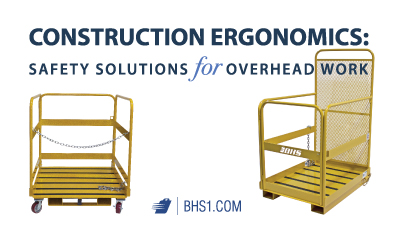We use cookies to make your experience better. To comply with the new e-Privacy directive, we need to ask for your consent to set the cookies. Learn more.
Construction Ergonomics: Safety Solutions for Overhead Work
The right construction ergonomics program can prevent costly injuries, improve staff morale, and boost productivity. But different tasks create different ergonomic risks. Workers who spend most of the shift with arms raised and necks tilted back — while installing conduit, ducting, or overhead lighting, for instance — may develop any number of musculoskeletal disorders.
Here are a few tips for safely completing overhead work without sacrificing efficiency. In fact, improving ergonomics for overhead work may actually reduce sick days and make the job more efficient.

Before we can get to the solutions, though, we should investigate the ways overhead work can lead to injuries. These are just a few of the conditions and injuries associated with working overhead on construction sites, according to research from the National Institute for Occupational Safety and Health (NIOSH):
-
Arthritis of the neck.
Staring upwards places strain on the neck, which can eventually manifest as arthritis. Workers who have a history of neck injuries are at a heightened risk of developing this condition.
-
Tension neck syndrome.
Strained muscles in the neck can lead to pain, stiffness, and spasms. Together, these symptoms go under the umbrella of "tension neck syndrome."
-
Neck sprains.
As we mentioned, when you tilt your head back, you place muscles and ligaments under heightened strain. When you maintain this posture for long periods of time, you might damage the ligaments of the neck, leading to a painful sprain.
-
Tendinitis of the shoulder.
Reaching overhead, especially with heavy tools in hand, places stress on tendons in the shoulder. Over time, these tendons can become inflamed, causing soreness and reduced range of motion.
-
Torn rotator cuff.
The rotator cuff is a system of muscles and tendons that encircles the shoulder joint, producing the wide range of motion that allows us to work overhead in the first place. However, ongoing stress can take its toll on the rotator cuff; this tissue can even tear, leading to a painful condition that can limit the worker's ability to reach upwards at all.
Because repetitive tasks cause stress on muscles, joints, and other soft tissues, the simplest solution is to find ways to accomplish jobs with as little overhead work as possible. This can be accomplished through pre-drilling components or even by partially building structures before securing them into place overhead.
Additionally, consider implementing the following ergonomic practices for construction tasks involving overhead work:
-
Use personnel lifts and work platforms to avoid overhead reaches.
Perhaps the simplest way to eliminate overhead work is to raise the worker to task height. This doesn't necessarily require expensive new lift units; with Forklift Work Platforms and Picking Work Platforms, users can convert an existing lift truck into a safe, OSHA-compliant elevated workspace.
-
Use Lift Tables to raise materials and tools rather than lifting them manually from ground level.
Repetitive lifting is a leading ergonomic hazard associated with overhead work. Rather than picking tools up from tables or the floor, use Powered Mobile Lift Tables to raise objects without strain.
-
When you can't raise the work to a comfortable height, or raise the worker to a natural position, use bit extensions and other elongated tools to keep tools between waist and shoulder-level.
Elevated platforms and lift tables can't solve every ergonomic hazard. Sometimes — particularly when working with screw guns and drills — the best solution is to use a bit extension shaft. These tools elongate the bit-end of the tool, allowing workers to keep the arms within a safe range of motion during overhead tasks.
Some amount of overhead work may be unavoidable for certain construction trades. But employers must strive to provide solutions that keep awkward postures to a minimum. Given the years of research and study at institutions like NIOSH, we have a good idea of how to improve construction ergonomics for overhead tasks; start with the tips listed above.
References:
"Simple Solutions: Ergonomics for Construction Workers." CDC. Centers for Disease Control and Prevention, National Institute for Occupational Safety and Health, 2007. PDF. 23 Aug. 2018.
